Solar-Powered Thermoelectric-Based Cooling and Heating System for Building Applications: A Parametric Study
Abstract
:1. Introduction
2. System Description and Method
2.1. Methodology
2.2. Building Energy Model
3. Results and Discussion
3.1. Weather Data, Cooling and Heating Load, and Solar Power
3.2. Thermoelectric Module Performance
3.3. Parametric Study
3.4. Economic Analysis
4. Prospects and Challenges
5. Conclusions
Author Contributions
Funding
Conflicts of Interest
References
- Ruparathna, R.; Hewage, K.; Sadiq, R. Improving the energy efficiency of the existing building stock: A critical review of commercial and institutional buildings. Renew. Sustain. Energy Rev. 2015, 53, 1032–1045. [Google Scholar] [CrossRef]
- Global Energy Assessment Writing Team. Energy End-Use-Buildings. In Global Energy Assessment Writing Team; Cambridge University Press: Cambridge, UK, 2012; Chapter 10-IIASA. [Google Scholar]
- Betharte, O.; Najafi, H.; Nguyen, T. Towards Net-Zero Energy Buildings: A Case Study in Humid Subtropical Climate. In Proceedings of the ASME 2018 International Mechanical Engineering Congress and Exposition, Pittsburgh, PA, USA, 9–15 November 2018. [Google Scholar] [CrossRef]
- Riffat, S.; Ma, X. Thermoelectrics: A review of present and potential applications. Appl. Therm. Eng. 2003, 23, 913–935. [Google Scholar] [CrossRef]
- Zhao, D.; Tan, G. A review of thermoelectric cooling: Materials, modeling and applications. Appl. Therm. Eng. 2014, 66, 15–24. [Google Scholar] [CrossRef]
- Bhargava, A.; Najafi, H. Photovoltaic-Thermoelectric Systems for Building Cooling Applications: A Preliminary Study. In Proceedings of the ASME 2016 International Mechanical Engineering Congress and Exposition, Phoenix, AZ, USA, 11–17 November 2016. [Google Scholar] [CrossRef]
- Twaha, S.; Zhu, J.; Yan, Y.; Li, B. A comprehensive review of thermoelectric technology: Materials, applications, modelling and performance improvement. Renew. Sustain. Energy Rev. 2016, 65, 698–726. [Google Scholar] [CrossRef]
- Liu, D.; Zhao, F.-Y.; Yang, H.; Tang, G.-F. Thermoelectric mini cooler coupled with micro thermosiphon for CPU cooling system. Energy 2015, 83, 29–36. [Google Scholar] [CrossRef]
- Ahammed, N.; Asirvatham, G.; Wongwises, S. Thermoelectric cooling of electronic devices with nanofluid in a multiport minichannel heat exchanger. Exp. Therm. Fluid Sci. 2016, 74, 81–90. [Google Scholar] [CrossRef]
- Zhang, H.; Kong, W.; Dong, F.; Xu, H.; Chen, B.; Ni, M. Application of cascading thermoelectric generator and cooler for waste heat recovery from solid oxide fuel cells. Energy Convers. Manag. 2017, 148, 1382–1390. [Google Scholar] [CrossRef]
- Najafi, H.; Woodbury, K.A. Modeling and Analysis of a Combined Photovoltaic-Thermoelectric Power Generation System. J. Sol. Energy Eng. 2013, 135, 031013. [Google Scholar] [CrossRef]
- Tan, Y.Z.; Han, L.; Chew, N.G.P.; Chow, W.H.; Wang, R.; Chew, J.W. Membrane distillation hybridized with a thermoelectric heat pump for energy-efficient water treatment and space cooling. Appl. Energy 2018, 231, 1079–1088. [Google Scholar] [CrossRef]
- Rahbar, N.; Esfahani, J.A. Experimental study of a novel portable solar still by utilizing the heatpipe and thermoelectric module. Desalination 2012, 284, 55–61. [Google Scholar] [CrossRef]
- Najafi, H.; Woodbury, K.A. Optimization of a cooling system based on Peltier effect for photovoltaic cells. Sol. Energy 2013, 91, 152–160. [Google Scholar] [CrossRef]
- Najafi, H. Evaluation of Alternative Cooling Techniques for Photovoltaic Panels; University of Alabama: Tuscaloosa, AL, USA, 2012. [Google Scholar]
- Zuazua-Ros, A.; Martín-Gómez, C.; Ibañez-Puy, E.; Vidaurre-Arbizu, M.; Gelbstein, Y. Investigation of the thermoelectric potential for heating, cooling and ventilation in buildings: Characterization options and applications. Renew. Energy 2018, 131, 229–239. [Google Scholar] [CrossRef]
- Liu, Z.; Zhang, L.; Gong, G.; Luo, Y.; Meng, F. Evaluation of a prototype active solar thermoelectric radiant wall system in winter conditions. Appl. Therm. Eng. 2015, 89, 36–43. [Google Scholar] [CrossRef]
- Birthwright, R.-S.; Messac, A.; Harren-Lewis, T.; Rangavajhala, S. Heat Compensation in Buildings Using Thermoelectric Windows: An Energy Efficient Window Technology. In Proceedings of the ASME 2008 International Design Engineering Technical Conferences and Computers and Information in Engineering Conference, Brooklyn, NY, USA, 3–6 August 2008; Volume 1, pp. 977–987. [Google Scholar] [CrossRef]
- Van Dessel, S.; Foubert, B. Active thermal insulators: Finite elements modeling and parametric study of thermoelectric modules integrated into a double pane glazing system. Energy Build. 2010, 42, 1156–1164. [Google Scholar] [CrossRef]
- Zhang, J.; Messac, A.; Zhang, J.; Chowdhury, S. Adaptive optimal design of active thermoelectric windows using surrogate modeling. Optim. Eng. 2013, 15, 469–483. [Google Scholar] [CrossRef]
- Liu, Z.; Zhang, L.; Gong, G.; Han, T. Experimental evaluation of an active solar thermoelectric radiant wall system. Energy Convers. Manag. 2015, 94, 253–260. [Google Scholar] [CrossRef]
- Luo, Y.; Zhang, L.; Liu, Z.; Wang, Y.; Meng, F.; Wu, J. Thermal performance evaluation of an active building integrated photovoltaic thermoelectric wall system. Appl. Energy 2016, 177, 25–39. [Google Scholar] [CrossRef]
- Martín-Gómez, C.; Ibáñez-Puy, M.; Bermejo-Busto, J.; Fernández, J.A.S.; Ramos, J.C.; Rivas, A. Thermoelectric cooling heating unit prototype. Build. Serv. Eng. Res. Technol. 2015, 37, 431–449. [Google Scholar] [CrossRef]
- Irshad, K.; Habib, K.; Basrawi, F.; Saha, B. Study of a thermoelectric air duct system assisted by photovoltaic wall for space cooling in tropical climate. Energy 2017, 119, 504–522. [Google Scholar] [CrossRef]
- Piantanida, P. PV & Peltier Façade: Preliminary Experimental Results. Energy Procedia 2015, 78, 3477–3482. [Google Scholar] [CrossRef] [Green Version]
- American Society of Heating, Refrigerating and Air-Conditioning Engineers. 2012 ASHRAE Handbook: Heating, Ventilating, and Air-Conditioning Systems and Equipment; ASHRAE: Atlanta, GA, USA, 2012. [Google Scholar]
- Rhee, K.-N.; Kim, K.W. A 50 year review of basic and applied research in radiant heating and cooling systems for the built environment. Build. Environ. 2015, 91, 166–190. [Google Scholar] [CrossRef]
- Zhao, K.; Liu, X.-H.; Jiang, Y. Application of radiant floor cooling in large space buildings—A review. Renew. Sustain. Energy Rev. 2016, 55, 1083–1096. [Google Scholar] [CrossRef]
- Chiang, W.-H.; Wang, C.-Y.; Huang, J.-S. Evaluation of cooling ceiling and mechanical ventilation systems on thermal comfort using CFD study in an office for subtropical region. Build. Environ. 2012, 48, 113–127. [Google Scholar] [CrossRef]
- Kazanci, O.B.; Shukuya, M.; Olesen, B.W. Theoretical analysis of the performance of different cooling strategies with the concept of cool exergy. Build. Environ. 2016, 100, 102–113. [Google Scholar] [CrossRef] [Green Version]
- Bojić, M.; Cvetković, D.; Marjanović, V.; Blagojević, M.; Djordjević, Z. Performances of low temperature radiant heating systems. Energy Build. 2013, 61, 233–238. [Google Scholar] [CrossRef] [Green Version]
- Li, R.; Yoshidomi, T.; Ooka, R.; Olesen, B.W. Field evaluation of performance of radiant heating/cooling ceiling panel system. Energy Build. 2015, 86, 58–65. [Google Scholar] [CrossRef]
- Lertsatitthanakorn, C.; Tipsaenprom, W.; Srisuwan, W.; Atthajariyakul, S. Study on the Cooling Performance and Thermal Comfort of a Thermoelectric Ceiling Cooling Panel System. Indoor Built Environ. 2008, 17, 525–534. [Google Scholar] [CrossRef]
- Lertsatitthanakorn, C.; Srisuwan, W.; Atthajariyakul, S. Experimental performance of a thermoelectric ceiling cooling panel. Int. J. Energy Res. 2008, 32, 950–957. [Google Scholar] [CrossRef]
- Lertsatitthanakorn, C.; Wiset, L.; Atthajariyakul, S. Evaluation of the Thermal Comfort of a Thermoelectric Ceiling Cooling Panel (TE-CCP) System. J. Electron. Mater. 2009, 38, 1472–1477. [Google Scholar] [CrossRef]
- Cheng, T.-C.; Cheng, C.-H.; Huang, Z.-Z.; Liao, G.-C. Development of an energy-saving module via combination of solar cells and thermoelectric coolers for green building applications. Energy 2011, 36, 133–140. [Google Scholar] [CrossRef]
- He, W.; Zhou, J.; Hou, J.; Chen, C.; Ji, J. Theoretical and experimental investigation on a thermoelectric cooling and heating system driven by solar. Appl. Energy 2013, 107, 89–97. [Google Scholar] [CrossRef]
- Liu, Z.; Zhang, L.; Gong, G. Experimental evaluation of a solar thermoelectric cooled ceiling combined with displacement ventilation system. Energy Convers. Manag. 2014, 87, 559–565. [Google Scholar] [CrossRef]
- Su, X.; Zhang, L.; Liu, Z.; Luo, Y.; Chen, D.; Li, W. Performance evaluation of a novel building envelope integrated with thermoelectric cooler and radiative sky cooler. Renew. Energy 2021, 171, 1061–1078. [Google Scholar] [CrossRef]
- Luo, Y.; Yan, T.; Zhang, N. Study on dynamic thermal characteristics of thermoelectric radiant cooling panel system through a hybrid method. Energy 2020, 208, 118413. [Google Scholar] [CrossRef] [PubMed]
- Lim, H.; Kang, Y.-K.; Jeong, J.-W. Application of a phase change material to a thermoelectric ceiling radiant cooling panel as a heat storage layer. J. Build. Eng. 2020, 32, 101787. [Google Scholar] [CrossRef]
- Duan, M.; Sun, H.; Lin, B.; Wu, Y. Evaluation on the applicability of thermoelectric air cooling systems for buildings with thermoelectric material optimization. Energy 2021, 221, 119723. [Google Scholar] [CrossRef]
- Chen, J.; Lu, L. Development of radiative cooling and its integration with buildings: A comprehensive review. Sol. Energy 2020, 212, 125–151. [Google Scholar] [CrossRef]
- National Renewable Energy Laboratory. PVWatts Calculator. Available online: https://pvwatts.nrel.gov/ (accessed on 20 April 2021).
- TE Technology. Hp-127-1.4-1.15-71. 2018. Available online: https://tetech.com/product/hp-127-1-4-1-15-71/ (accessed on 1 April 2021).
- Ford, B.; Schiano-Phan, R.; Vallejo, J.A. The Architecture of Natural Cooling, 2nd ed.; Routledge: London, UK, 2019. [Google Scholar] [CrossRef]
- Widera, B. Bioclimatic Architecture. J. Civ. Eng. Archit. Res. 2015, 2, 567–578. [Google Scholar]
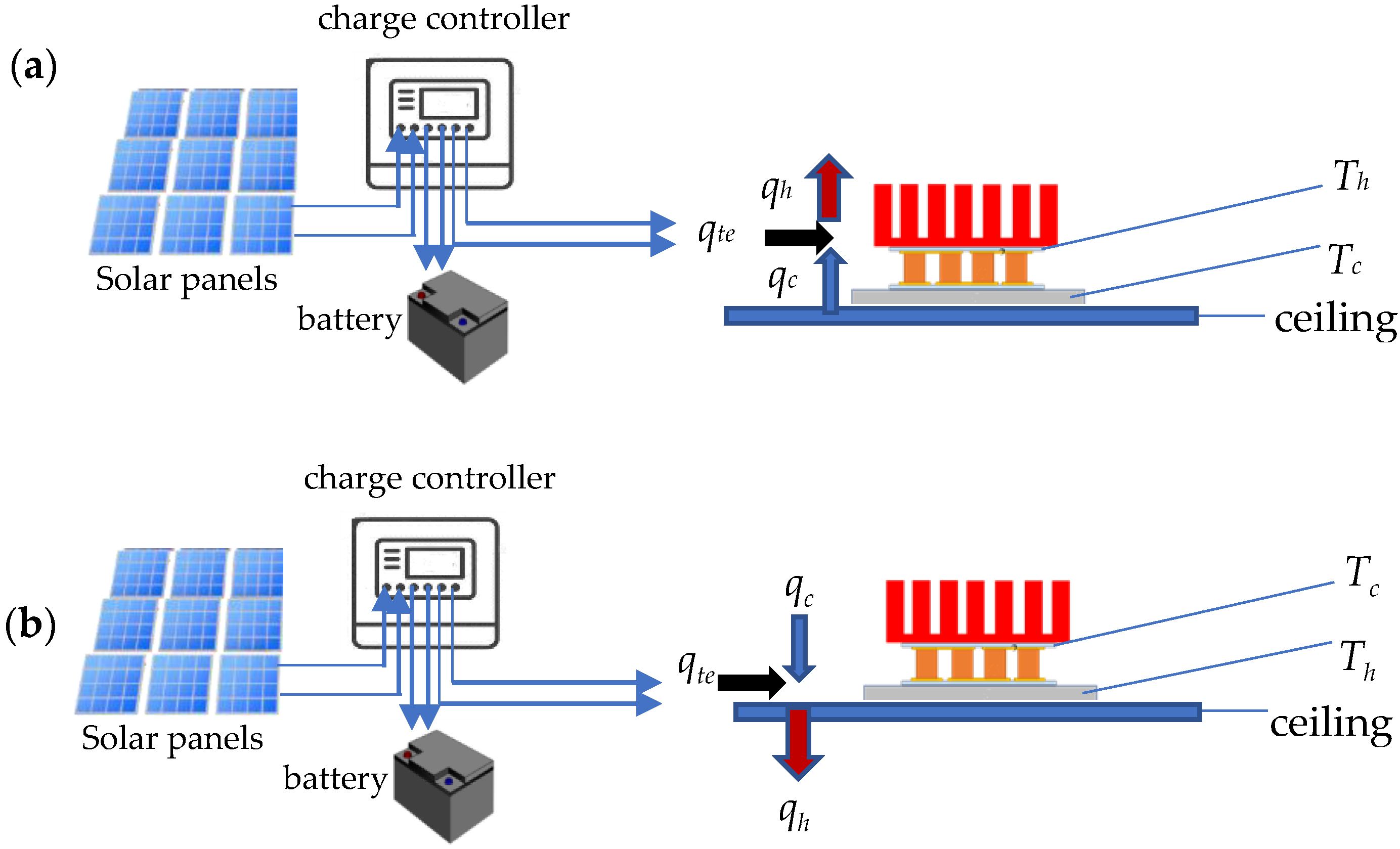
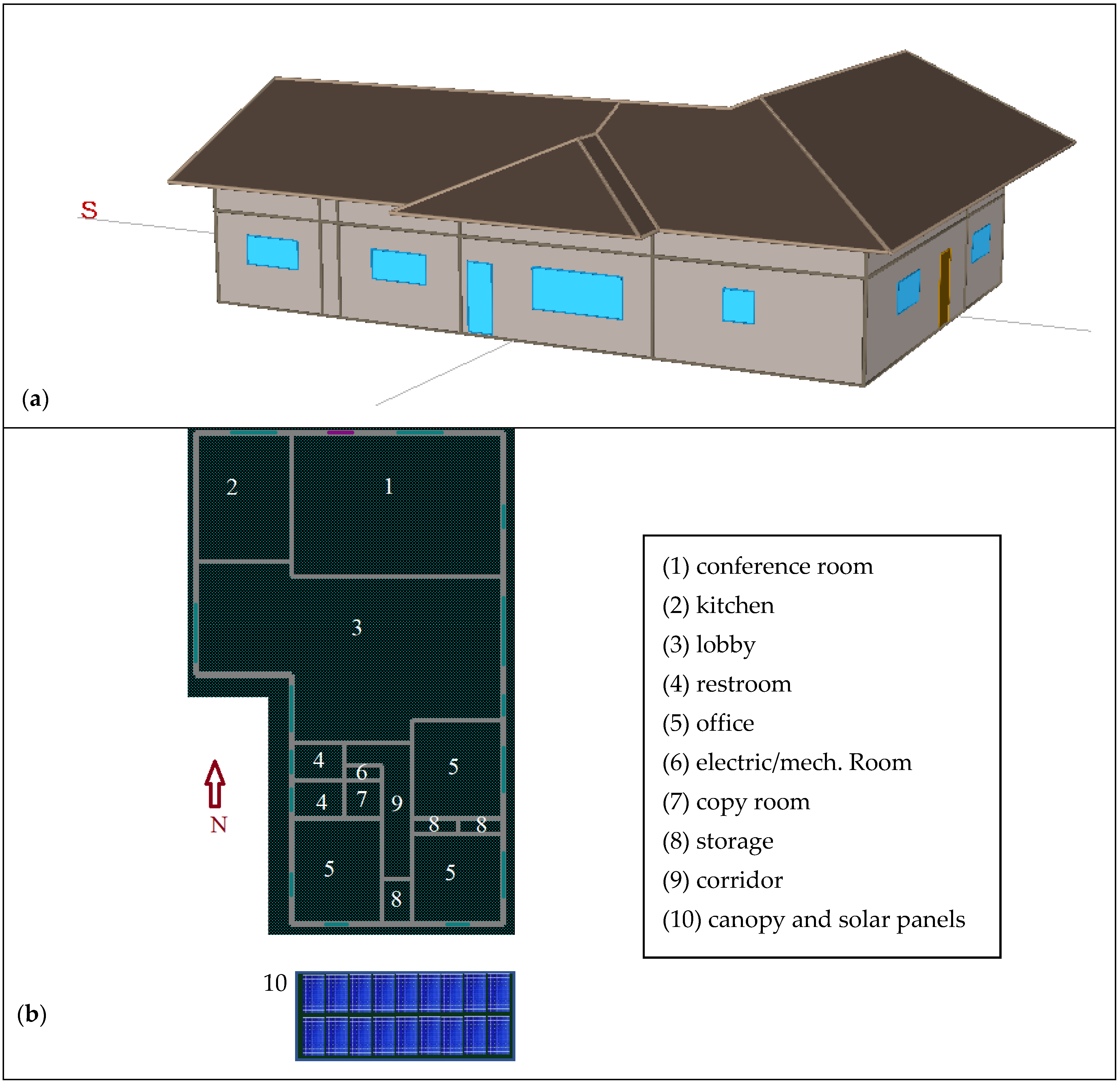

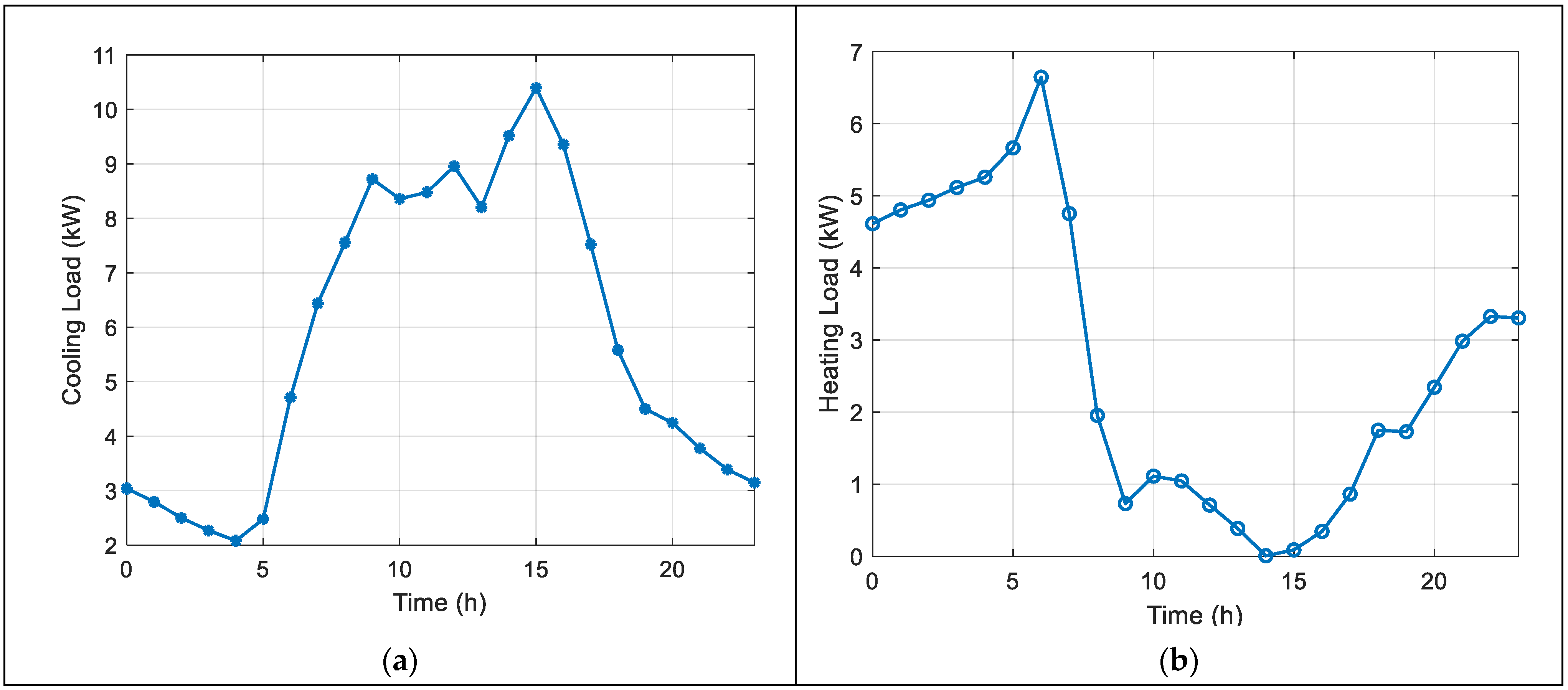
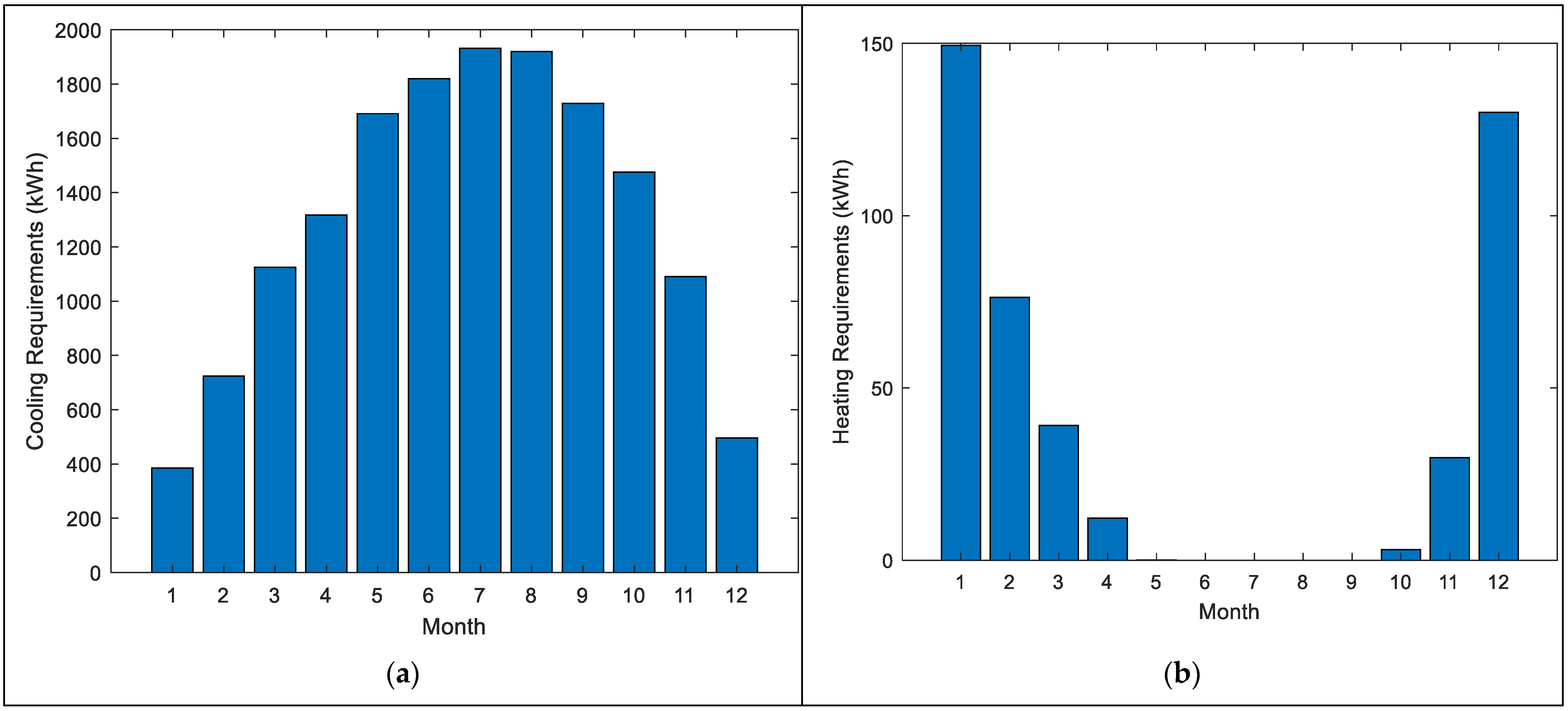
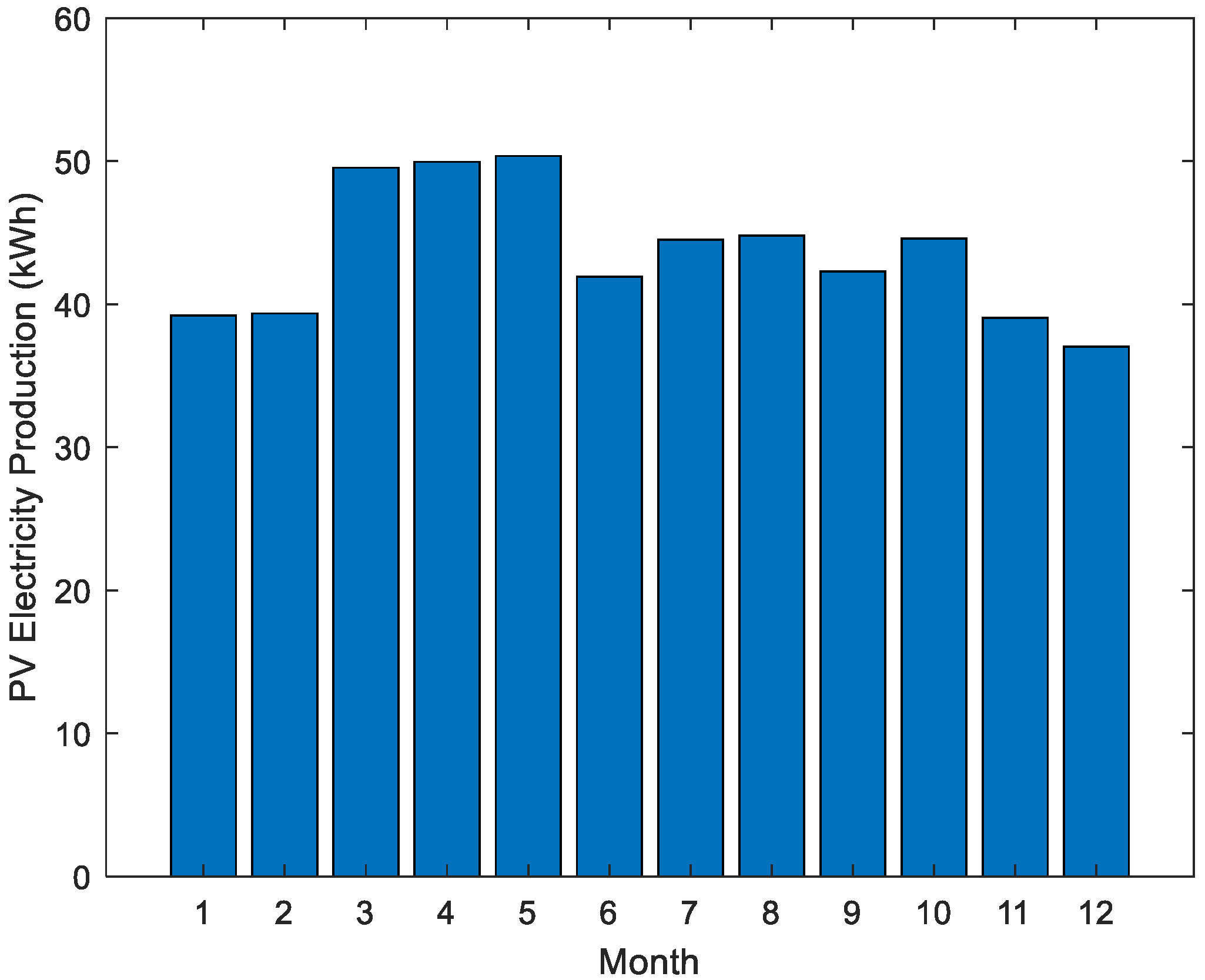
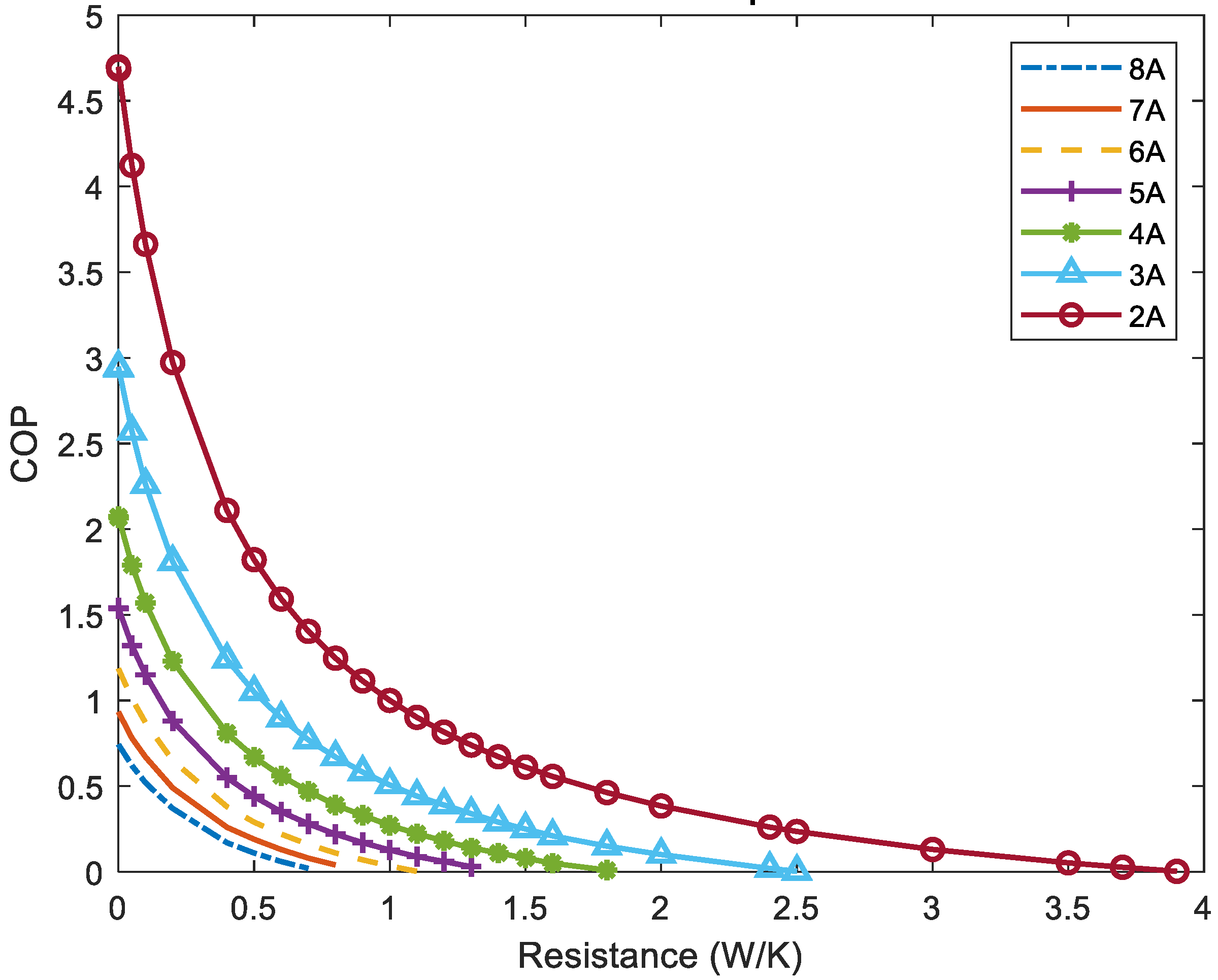


| Windows | |||||
|---|---|---|---|---|---|
| Orientation | Num | Glass Type | Frame Type | Size (cm) | Dist. to Ground (cm) |
| East | 1 | Clear | Wood/AL | 88.9 × 124.5 | 83.8 |
| East | 2 | Clear | Wood/AL | 182.9 × 91.4 | 121.9 |
| South | 2 | Clear | Wood/AL | 91.4 × 94.0 | 129.5 |
| West | 2 | Clear | Wood/AL | 91.4 × 94.0 | 116.8 |
| West | 1 | Clear | Wood/AL | 182.9 × 94.0 | 116.8 |
| North | 2 | Clear | Wood/AL | 182.9 × 91.4 | 129.5 |
| Doors | |||||
| Orientation | Num | Type | Size (cm) | ||
| East | 1 | Glass (Metal Frame) | 76.2 × 181.6 | ||
| West | 1 | Sliding Glass | 152.4 × 213.4 | ||
| North | 1 | Wood | 91.4 × 213.4 × 4.5 | ||
| Plug Loads | ||||
|---|---|---|---|---|
| Type | Location | Num | Wattage | Hours/year |
| Computer | Offices | 4 | 130 | 2000 |
| Refrigerator | Kitchen | 1 | 180 | 8742 |
| Microwave | Kitchen | 1 | 1200 | 125 |
| TV | Kitchen | 1 | 300 | 1250 |
| Coffee Pot | Kitchen | 1 | 750 | 500 |
| Lights | ||||
| Type | Location | Num | Wattage | Hours/year |
| T8 | All | 56 | 32 | 1821 |
| T2 | Bath | 9 | 13 | 4500 |
| A19 | Closet | 1 | 75 | 15 |
| A15 | Closet | 1 | 55 | 15 |
| GU24 | Garage | 1 | 13 | 15 |
| PV Panel | Thermoelectric Module | ||
|---|---|---|---|
| Dimensions of the PV panel | 1038 × 533 × 35 mm | VTE,max | 16.1 V |
| Rated power | 330 W | ITE,max | 8 A |
| Nominal cell efficiency | 19.7% | ΔTTE,max | 71 K |
| Maximum power voltage, Vmp | 58 V | QTE,max | 80 W |
| Maximum power current, Imp | 5.7 A | Dimensions | 40 × 40 mm |
| Open circuit voltage, Voc | 69.7 V | ||
| Short circuit current, Isc | 6.07 | ||
| Cooling | Heating | ||||||||||||
|---|---|---|---|---|---|---|---|---|---|---|---|---|---|
| Case Num | ΔT (°C) | V | COPc | qc (W) | qte,c (W) | Ntec | Qtec,y (kWh/yr) | Npv,c | Cinit,c ($) | COPh | qh (W) | Nteh | Qteh,y (kWh/yr) |
| 1 | 9.6 | 2.9 | 3 | 14 | 4.67 | 743 | 5236 | 11 | 22,700 | 4 | 18.67 | 358 | 110 |
| 2 | 9.6 | 5.9 | 1.7 | 37 | 21.76 | 282 | 9239 | 18 | 13,800 | 2.7 | 58.76 | 114 | 163 |
| 3 | 9.6 | 8.8 | 1 | 45 | 45.00 | 232 | 15,707 | 31 | 17,425 | 2 | 90.00 | 75 | 220 |
| 4 | 9.6 | 11.7 | 0.8 | 52 | 65.00 | 200 | 19,634 | 38 | 19,250 | 1.8 | 117.00 | 58 | 244 |
| 5 | 12 | 5.9 | 1.62 | 38 | 23.46 | 274 | 9696 | 19 | 13,975 | 2.62 | 61.46 | 109 | 168 |
| 6 | 12 | 8.8 | 1.14 | 45 | 39.47 | 232 | 13,778 | 27 | 15,925 | 2.14 | 84.47 | 79 | 206 |
| 7 | 12 | 11.7 | 0.78 | 52 | 66.67 | 200 | 20,137 | 39 | 19,625 | 1.78 | 118.67 | 57 | 247 |
| 8 | 19.2 | 5.9 | 1.3 | 23 | 17.69 | 453 | 12,082 | 24 | 20,325 | 2.3 | 40.69 | 164 | 191 |
| 9 | 19.2 | 8.8 | 0.9 | 36 | 40.00 | 289 | 17,452 | 34 | 19,975 | 1.9 | 76.00 | 88 | 232 |
| 10 | 19.2 | 11.7 | 0.6 | 44 | 73.33 | 237 | 26,178 | 51 | 25,050 | 1.6 | 117.33 | 57 | 275 |
| 11 | 28.8 | 5.9 | 0.8 | 10 | 12.50 | 1040 | 19,634 | 38 | 40,250 | 1.8 | 22.50 | 297 | 244 |
| 12 | 28.8 | 8.8 | 0.7 | 26 | 37.14 | 400 | 22,439 | 43 | 26,125 | 1.7 | 63.14 | 106 | 259 |
| 13 | 28.8 | 11.7 | 0.5 | 34 | 68.00 | 306 | 31,414 | 61 | 30,525 | 1.5 | 102.00 | 66 | 293 |
| 14 | 38.3 | 8.8 | 0.5 | 16 | 32.00 | 650 | 31,414 | 61 | 39,125 | 1.5 | 48.00 | 139 | 293 |
| 15 | 38.3 | 11.7 | 0.4 | 24 | 60.00 | 434 | 39,268 | 76 | 39,350 | 1.4 | 84.00 | 80 | 314 |
Publisher’s Note: MDPI stays neutral with regard to jurisdictional claims in published maps and institutional affiliations. |
© 2021 by the authors. Licensee MDPI, Basel, Switzerland. This article is an open access article distributed under the terms and conditions of the Creative Commons Attribution (CC BY) license (https://creativecommons.org/licenses/by/4.0/).
Share and Cite
Seyednezhad, M.; Najafi, H. Solar-Powered Thermoelectric-Based Cooling and Heating System for Building Applications: A Parametric Study. Energies 2021, 14, 5573. https://doi.org/10.3390/en14175573
Seyednezhad M, Najafi H. Solar-Powered Thermoelectric-Based Cooling and Heating System for Building Applications: A Parametric Study. Energies. 2021; 14(17):5573. https://doi.org/10.3390/en14175573
Chicago/Turabian StyleSeyednezhad, Mohadeseh, and Hamidreza Najafi. 2021. "Solar-Powered Thermoelectric-Based Cooling and Heating System for Building Applications: A Parametric Study" Energies 14, no. 17: 5573. https://doi.org/10.3390/en14175573
APA StyleSeyednezhad, M., & Najafi, H. (2021). Solar-Powered Thermoelectric-Based Cooling and Heating System for Building Applications: A Parametric Study. Energies, 14(17), 5573. https://doi.org/10.3390/en14175573






